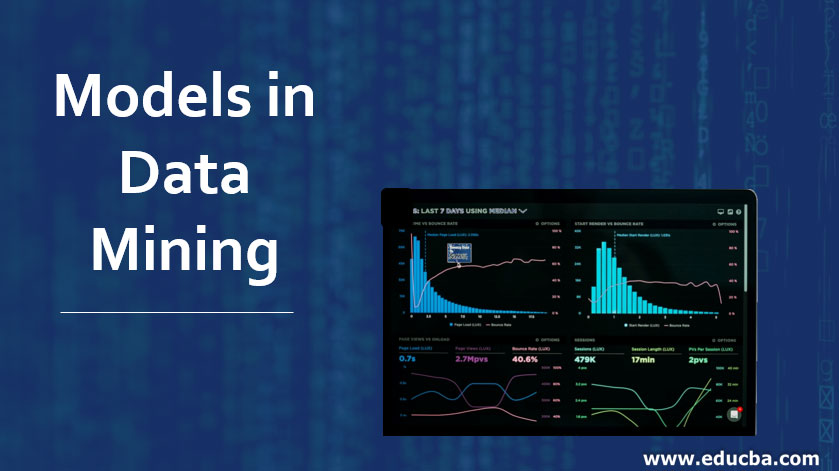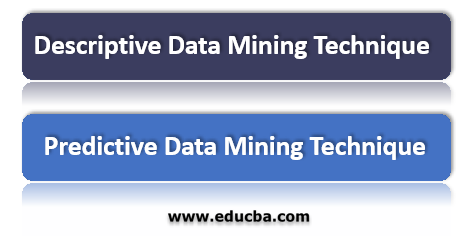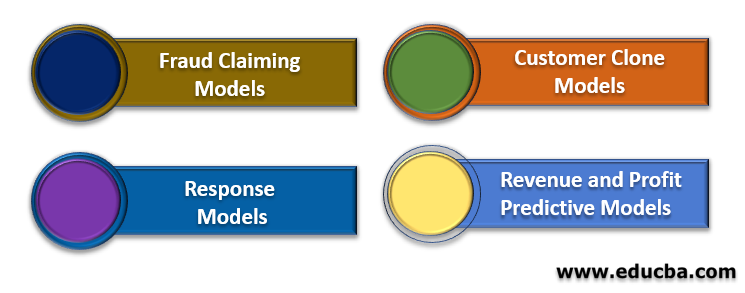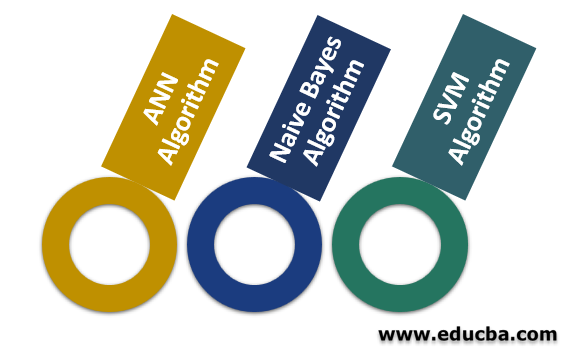Updated March 23, 2023

Introduction to Models in Data Mining
Data Mining uses raw data to extract information or, in fact, mining the required information from data. Data Mining is used in the most diverse range of applications, including political model forecasting, weather pattern model forecasting, website ranking forecasting, etc. Data mining is also used in organizations that use big data as their raw data source to mine the required data, which can be quiet complex.
Techniques Used in Data Mining
Data Mining mode is created by applying the algorithm on top of the raw data. The mining model is more than the algorithm or metadata handler. It is a set of data, patterns, statistics that can be serviceable on new data that is being sourced to generate the predictions and get some inference about the relationships. The following are some of the techniques that are used in data mining.
1. Descriptive Data Mining Technique
This technique is generally preferred to generate cross-tabulation, correlation, frequency, etc. These descriptive data mining techniques are used to obtain information on the data’s regularity by using raw data as input and discovering important patterns. The other application of this is to understand the captivating groups in the wider area of the raw data.
2. Predictive Data Mining Technique
The main objective of the predictive mining technique is to identify futuristic results instead of the current tendency. Many functions are used for the prediction of the target value. The techniques that fall under this category are classification, regression and time-series analysis. Data modelling is a compulsion for this predictive analysis, which uses some variables to predict the uncertain futuristic data for other variables.
Types of Models in Data Mining
A few of the data mining models are mentioned below, along with their description:
1. Fraud Claiming Models
Fraud is the challenge faced by many industries and especially the insurance industry. These industries need to constantly predict using the raw data so that the fraud claims can be understood and acted upon. We can track the claims that arrive in the form of raw data and identify the likelihood of it being fraudulent, resulting in large savings for the insurance company.
2. Customer Clone Models
The customer clone model can predict which prospects are highly likely to respond based on the characteristics of the organization’s “best customers”.
3. Response Models
Predictive data mining response models help organisations identify the usage patterns that segregate their customer base to establish contact with those customers. This response model is the best method for predicting and identifying the customer base or prospects to the target for a particular product. The offering is in line with the use of a model developed. These models are applied in identifying the customers who are highly likely to possess the characteristic of being targeted.
4. Revenue and Profit Predictive Models
Revenue and Profit Prediction models combine the response or nonresponse characteristics with a given revenue estimate, especially if ordered sizes, margins are differing widely or monthly billings. As we know, not all the responses have the same or equal value, and the model that can increase the responses doesn’t necessarily gain our profit. Revenue and profit predictive technique indicate that those respondents who are highly likely to increase revenue or profit delta margin with their response than the other responders. These are some of the model types, and there are many more that can help ming the required data from the set of raw data.
Data Mining Algorithms
Many data mining algorithms are present; we will discuss a couple of them here. Let’s see why do we require the algorithm to mine the data. In today’s world, where data generation is huge, and big data is quite common, we need to have some algorithm that needs to apply to them to predict the pattern and analysis. We have different algorithms basing on the model of mining that we want to apply to our data. Some of them are shown below:
1. ANN Algorithm
This ANN algorithm is inspired by biological neural networks and is like typical computer architecture. This algorithm uses approximation functions on uncertain large numbers of data to get some pattern. They are generally represented as a system of interconnected neurons that can input and perform the computation to provide the output.
2. Naive Bayes Algorithm
The Naive Bayes Algorithm is based on the Bayesian Theorem, and this algorithm is used when we have the dimensions of the data are higher. The Bayesian Classifier is capable of providing the possible output by inputting the raw data. Here there is also the possibility of adding the new raw data at the run time and get the predictions. A naive Bayes classifier will consider all the probabilities before committing to the output.
3. SVM Algorithm
This SVM algorithm has gained a lot of attention in the past decade and is applied to the widest range of applications. This algorithm is based on statistical learning theory and structural risk assessment and minimization principle. It can identify the decision boundaries and is also called a hyperplane that can produce optimal separation of classes and thereby create the largest possible distance between the segregating hyperplane. SVM is the most robust and accurate classification technique but has the disadvantage of higher cost and time-consuming.
Advantages
There are many advantages of the data mining models, and some of them are listed below:
- These models help the organization to identify the customer’s shopping pattern and then suggests the appropriate steps that can be taken to increase the revenue.
- These models can help us to increase website optimization so that the customer can discover the required stuff easily.
- These models help us with marketing campaigns identifying the favourable area and methods.
- It will help us to identify the customer chunk and their needs so that the required products can be supplied.
- It helps to increase brand loyalty.
- It helps to measure the profitability of revenue increasing factors.
Conclusion
So we have seen the definition of data mining and why it is required and understood the difference between descriptive and predictive data ming models. Also, we have seen some data ming models and a few algorithms that help the organization gain better insight into the raw data. In the last, we have seen a few advantages with the data mining models.
Recommended Articles
This is a guide to Models in Data Mining. Here we discuss the Most Important Types of Models in Data Mining along with Advantages and Algorithms. You can also go through our other suggested articles to learn more –




